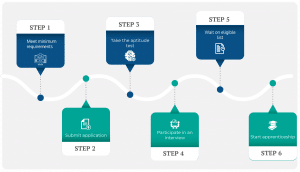The National Academy of Sports Medicine Certified Personal Trainer exam is also known as the NASM or NASM-CPT. It is one of the most sought-after personal trainer certifications by employers and will challenge your overall knowledge of personal fitness. The test is based on the NASM Certified Personal Trainer course.
The test contains 120 questions, and there is a two-hour time limit to complete the exam. There are 6 domains included in the exam, covering basic and applied sciences and nutritional concepts, assessment, program design, exercise technique and training instruction, client relations and behavioral coaching, and professional development and responsibility.
The test can be taken online or in person at a proctoring location and is included as part of the fee for the NASM Certified Personal Trainer course.
Did you know?
The NASM-CPT exam has six domains: (1) basic and applied sciences and nutritional concepts, (2) assessment, (3) program design, (4) exercise technique and training instruction, (5) client relations and behavioral coaching, and (6) professional development and responsibility. You must score a scaled score of 70 to pass the exam. To pass the test, you will need to display mastery of personal training based on the NASM course.
NASM CPT Question Types
The NASM CPT is divided into six domains. Each domain measures an ability or characteristic that is critical to your success as a personal trainer.
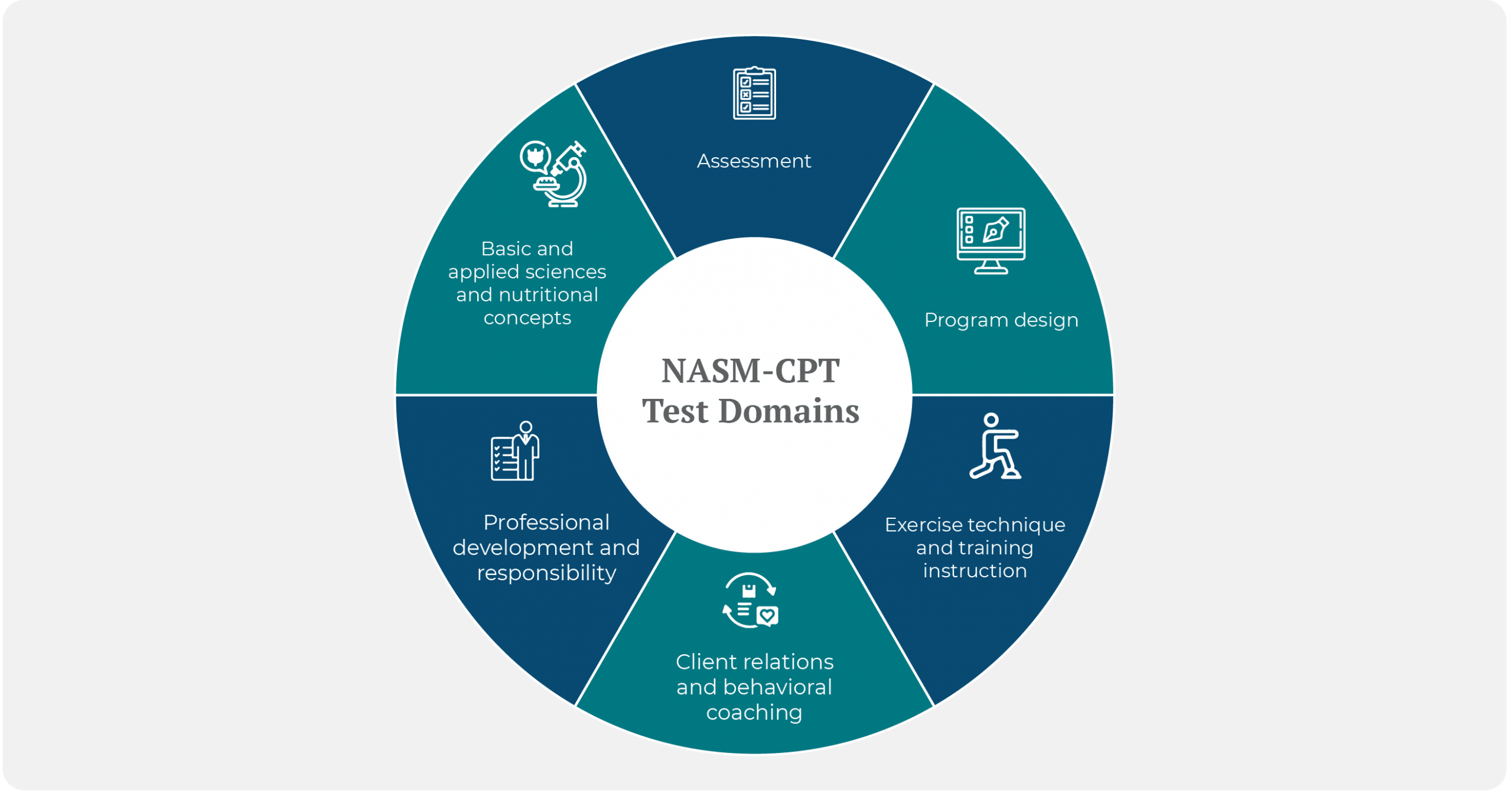
There are 120 questions on the test. Your score will be based on 100 of these questions, while the other 20 are used for research purposes and don’t impact your score.
| Domain | Percentage of test | Approximate number of questions | Time per question |
|---|---|---|---|
| Basic and applied sciences and nutritional concepts | 17% | 20 | 60 seconds |
| Assessment | 18% | 22 | 60 seconds |
| Program design | 21% | 25 | 60 seconds |
| Exercise technique and training instruction | 22% | 27 | 60 seconds |
| Client relations and behavioral coaching | 12% | 14 | 60 seconds |
| Professional development and responsibility | 10% | 12 | 60 seconds |
All the NASM test questions are multiple-choice, and each question has four answer options.
Domain 1 – Basic and Applied Sciences and Nutritional Concepts
This section tests your knowledge of human anatomy and the six body systems. Expect to see questions relating to concepts and structures of anatomy, the functions of exercise physiology as it relates to the different systems within the body, and functional biomechanics. The section also includes questions relating to functional biomechanics, principles of human movement, and principles of motor development.
In addition, this section will include questions covering macro and micronutrients, hydration, caloric intake, portion sizes, diets, nutritional supplements, food labeling, and factors relating to weight management physiology.
Domain 2 – Assessment
In the assessment section, you will be asked questions testing your knowledge of the Physical Activity Readiness Questionnaire (PAR-Q), essential elements of personal and family medical history, medical risk factors, and lifestyle concerns.
The section also covers your knowledge of cardiorespiratory assessments, physiological assessments, performance assessments, and movement assessments.
Additionally, you will be tasked with responding to questions covering criteria for reassessments, considerations for modifying assessments for special needs populations, indications that a client’s condition requires a referral, and the applicability of assessments from other health professionals.
Domain 3 – Program Design
The program design domain tests your knowledge of different training methods, including resistance and cardiovascular training. You will need to answer questions relating to program design for special populations, fitness technology, trends, risk vs. reward of different modalities, and the principles of specificity, overload, and variation.
Domain 4 – Exercise Technique and Training Instruction
In this domain, you will answer questions about kinesthetic, auditory, and visual cueing techniques. You will also be challenged to demonstrate your knowledge of safe training practices, safe spotting techniques, kinetic chain checkpoints, and signs or symptoms that require training modifications.
Domain 5 – Client Relations and Behavioral Coaching
This domain shifts from exercise to working with clients. It covers communication components, SMART goal development, goal expectation management, barriers to behavioral change, and client expectation management.
Domain 6 – Professional Development & Responsibility
The last section of the test examines your knowledge of professional and ethical guidelines and stresses the code of conduct. It reviews business fundamentals, marketing and sales, and equipment maintenance.
You’ll also answer questions about your professional liability, requirements for maintaining professional credentials, rules and regulations relating to personal trainers, and credible resources of information regarding health and fitness.
NASM-CPT Preparation Strategies
The NASM CPT test is based on NASM’s personal trainer program. The program has a range of options for taking the course, starting at $799 for a self-study course and going up to $2,698 for an all-inclusive course that includes virtual coaching.
Each program option includes practice exams, quizzes, and knowledge checks, which you should take to track your progress as you learn the material.
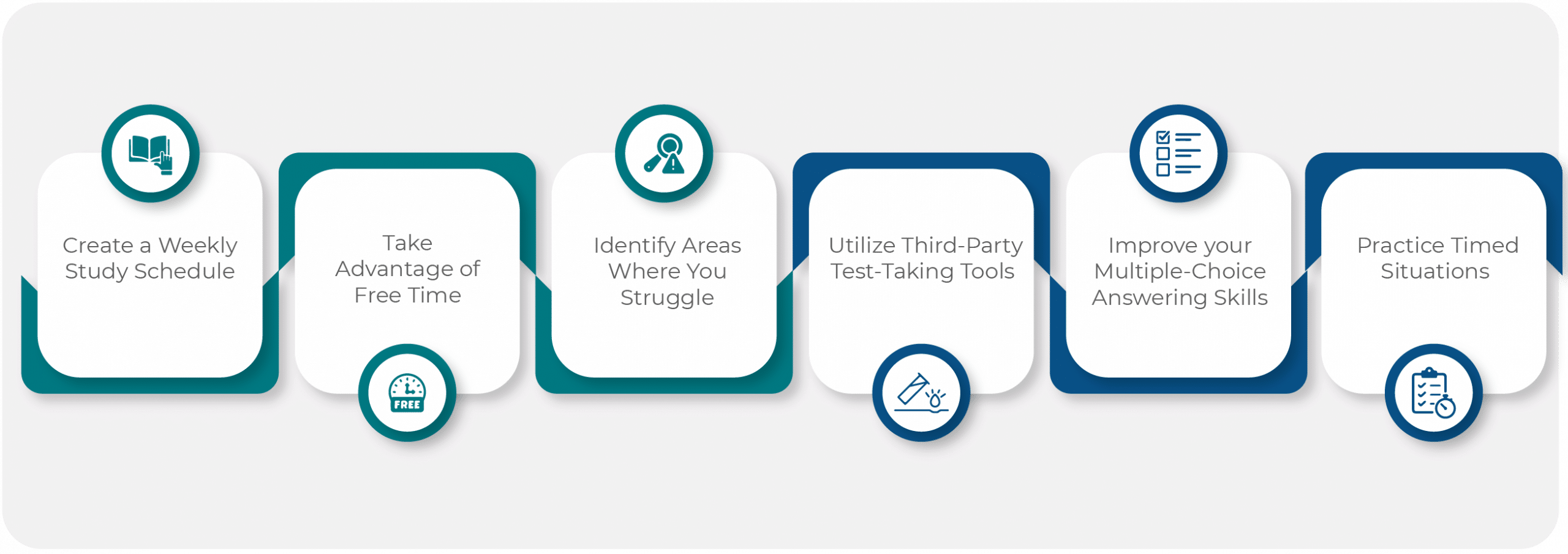
In addition to the NASM-provided materials, here are steps you should take to give yourself the best chance to pass the test:
1. Create a Weekly Study Schedule
Passing the NASM requires discipline. Build a weekly study plan using the calendar feature in your phone and follow it religiously. You will need to block off large chunks of time for studying if you are going to pass the test.
2. Take Advantage of Free Time
The NASM materials are all online. If you find yourself sitting in a waiting room, riding the bus, or having nothing to do, go to the site and read through the materials.
3. Identify Areas Where You Struggle
As you go through the course, take note of difficult material. Go through the entire NASM CPT textbook and track the concepts that you found most difficult. While studying, spend extra time on those sections.
4. Utilize Third-Party Test-Taking Tools
Sign up for iPrep’s NASM CPT course and take NASM practice tests until you are consistently scoring 100% in every section.
iPREP: Concise. Focused. What you need.
Sign up
Immediate access
Practice
Online self-paced
Pass
Ace that Test!
5. Improve your Multiple-Choice Answering Skills
All NASM exam questions are multiple choice, meaning you have a 1 in 4 chance at getting any question right. By improving your multiple-choice skills, you can eliminate answers and improve your chance of success. iPrep materials include tips for multiple choice tests and offer you time-saving tools to help you get through the test faster.
6. Practice Timed Situations
The closer you can simulate the test during practice, the more comfortable you will be on test day. Take online practice tests in an environment that closely mimics the conditions of the actual test.
Test Features
NASM Test Fast Facts (tl;dr)
- Total of 120 questions.
- Test is 2 hours long.
- There are 6 domains on the test:
- Basic and applied sciences and nutritional concepts
- Assessment
- Program design
- Exercise technique and training instruction
- Client relations and behavioral coaching
- Professional development and responsibility
- The test must be taken within 180 days of signing up for the CPT certification course. Extensions are available for a fee.
- The test is proctored, either through an online proctor or at a testing center.
- You will need to attest to a number of conditions before taking the test, including that you will abide by the rules of the test.
- You must show a government-issued photo ID and have a current CPR/AED certification test to take the NASM exam.
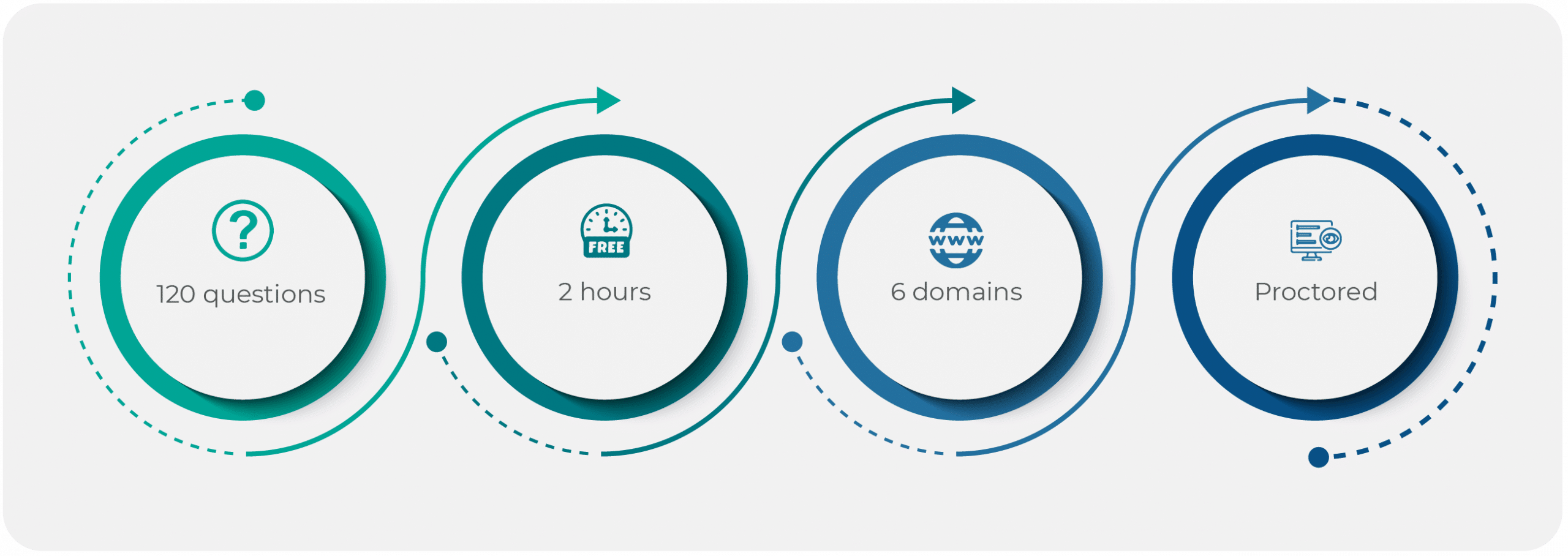
Here are some additional important features you should know about the NASM CPT Exam:
Registering for the exam
You should register for the exam at least 60 days before taking the tests to give yourself adequate time to prepare. However, you can register for it no later than 3 days before the test.
The NASM test is administered by PSI Services LLC, a standalone subsidiary of ETS. You will need to register with PSI to take the test, either by calling 800.211.2754 or at their website at https://candidate.psiexams.com/. You will receive confirmation of location, date, and time. You will not be admitted to the test at any other time, date, or location.
Exam Check-in
When you arrive at the testing facility, you will need to show a photo ID with a name that matches the name file with NASM and the name used to register for the exam at PSI.
You may only take the test at the location on your registration confirmation, and you must present a copy of your current CPR/AED certification card.
Rescheduling or Cancelling an Exam
There is no fee to reschedule the exam provided that you give notice to PSI more than 24 hours in advance. If you miss your scheduled exam, the cost of the exam is forfeited, and you will need to purchase a retest. In addition, you will be charged a late cancellation fee to cover the cost of the empty seat.
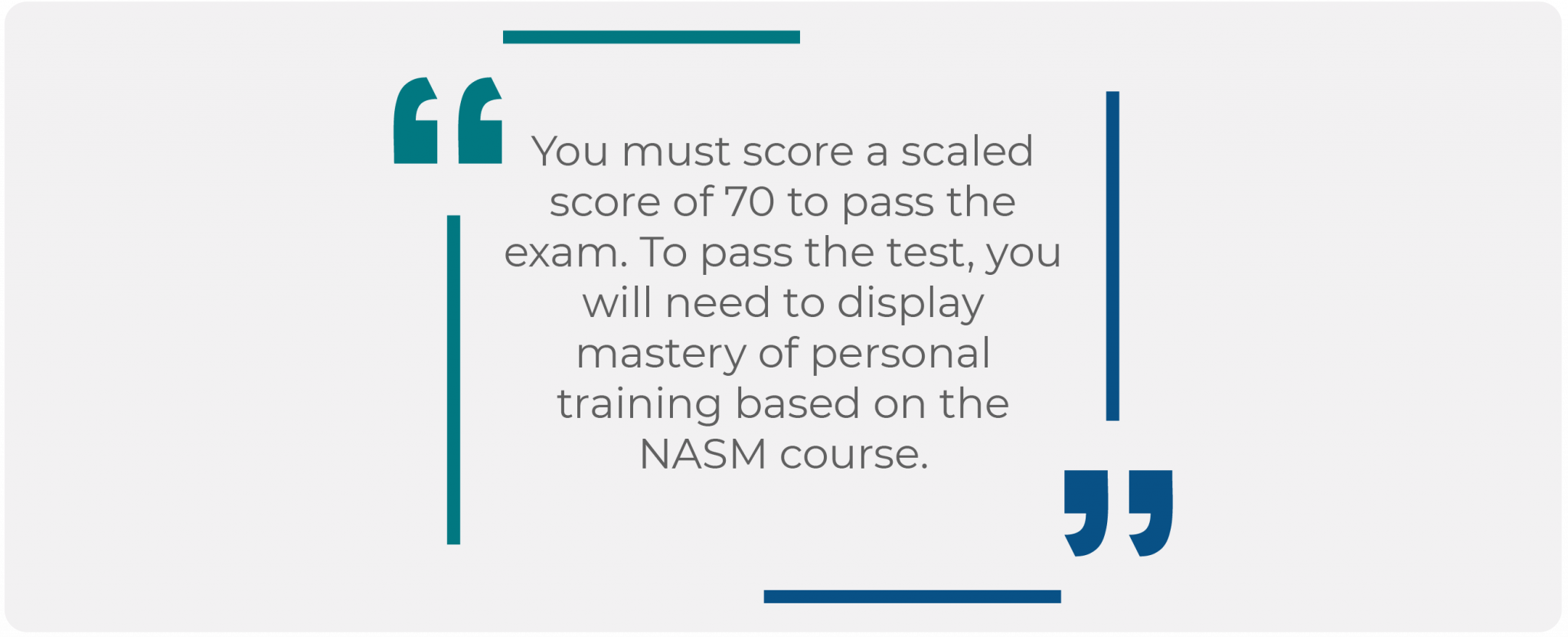
Remote Testing
Due to COVID-19, NASM has started to allow you to take the NASM exam online with a live remote proctor. Be in touch with the NASM Member Services department for more information at https://www.nasm.org/contact.
Retaking the Exam
If you don’t pass the NASM CPT exam, you can retake the test after 1 week. If you are unsuccessful on the second attempt, you may take a third attempt after a 30-day waiting period. Any additional failed exams require a 1-year waiting period.
Retests are included in the cost of the Guided Study and Virtual Coaching NASM CPT training packages. They cost $199 each for the self-study packages.
Results Scale and Interpretations
Tests are scored immediately upon completion, and you will receive a preliminary result. These results take approximately 2 weeks to confirm, as NASM reviews the results for anomalies, and there is the possibility that results will be rescored.
Raw scores are converted into scaled scores. A scaled score of 70 or higher is considered passing. If you pass the test, you will not be told your score.
Candidates who fail the test are given a breakdown of their scores to help them prepare for the retest.
Based on historical data, approximately 66% of test takers pass the test.
Those who pass will receive by mail their NASM Certified Personal trainer Certificate.
![NASM-Certified-Personal-trainer-Certificate.jpeg[1] NASM Certified Personal trainer Certificate](https://www.iprep.online/wp-content/uploads/2022/10/NASM-Certified-Personal-trainer-Certificate.jpeg1_.webp)
NASM-CPT FAQs
The NASM CPT exam is a certification test for aspiring personal trainers. It is the culmination of a comprehensive personal training course and is considered to be a top certification by employers.
The NASM is a 120-question test covering the materials that an aspiring personal trainer needs to know ranging from anatomy, physiology, nutrition, assessment, designing programs, working with clients, and professional development. The test covers six different domains.
Study the material from the NASM CPT certification course.
The test is challenging, but taking NASM CPT practice exams will help you prepare for the test. Approximately 2 out of 3 test-takers pass the test.
There are 120 questions on the NASM CPT text. Your score is based on 100 of these questions, while the additional 20 questions are for research purposes.
In order to take the test, you need to sign up for the NASM CPT certification program. Once you are signed up you can take the test when you feel you are ready.
Many candidates who have taken the official NASM practice exam report that it is very different from the actual exam. However, the practice exam does point to areas where you are weaker and need to spend more time studying.
The NASM offers its certification course with different levels of support. The regular price for the basic, self-study course is $799 and is the least expensive option.
You have 180 days from the time you sign up for the certification program until you have to take the test. Ideally, you should use that time to learn the material and study for the test.
You can’t trick the NASM test. The best way to pass the NASM CPT certification test is to learn the materials and study for the test. Create a structured study program, review areas where you are weak, and take practice tests to help identify areas of strength and weakness.
Yes, the NASM exam is multiple choice.
If you’d like to take the NASM CPT exam remotely, be in touch with the NASM Member Services department at https://www.nasm.org/contact.
To pass the NASM exam, you will need to score a scaled score of 70.
If you fail the NASM test you can take the test again. Depending on the certification course that you signed up for, you may need to pay for retests. You must wait at least 7 days before taking your second test. If you fail a second time, you must wait 30 days to take the test a third time. All additional attempts require you to wait one year.
Come certification packages include free retests. If your certification package does not include free retests, they cost $199 each.
You must be at least 18 and have either graduated from high school or completed a GED.
NASM-CPT Test Tips
- Read each question carefully
Many of the questions require you to apply material you’ve learned in the course to other situations.
- Manage your time
You only have one minute per question. Don’t spend too much time on any question.
- Know your strengths
If you come to a section that you can’t answer, guess and move on. You won’t lose points for wrong answers, but you will lose out by running out of time and not being able to answer questions you know at the end of the test.
- Get as many questions right as you can
Don’t worry about not getting all the answers right. You will receive the same certification with a 70 score as you will with a 100.
- Plan your NASM CPT Strategy
Your best bet for a great test day is planning, studying, and practicing. The more you practice leading up to test day, the more comfortable you will be when facing the actual test.
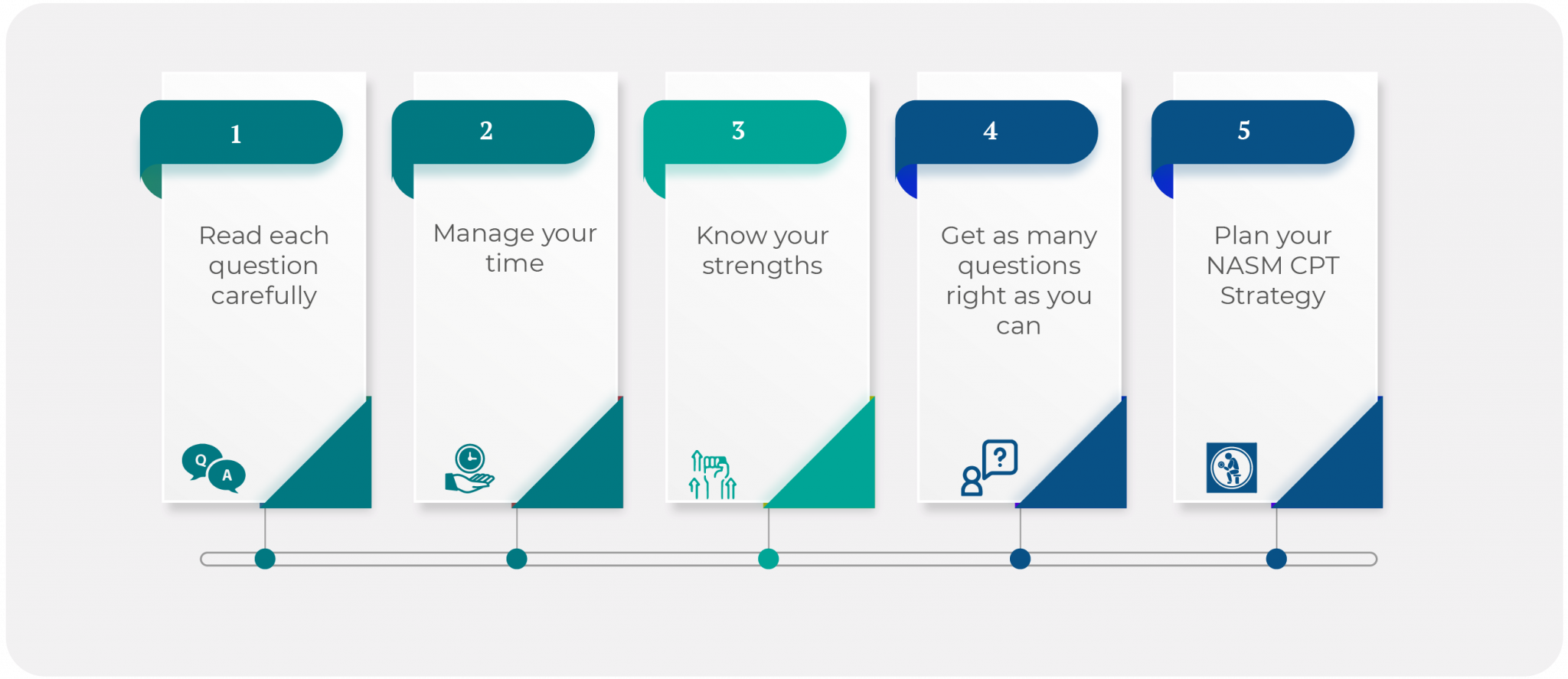
Administration
- Test Location: Tests are administered at PSI testing locations. Due to COVID-19, the test is also offered online via a live remote proctor.
- Test Schedule: Contact the PSI center to find out when the test is available
- Test Format: Multiple choice on a computer
- Test Materials: Test is administered on computer. You may not use any resources while taking the test.
- Cost: The NASM CPT course starts at $799 and includes the test. Retakes may be included depending on the course package you purchased. If it is not included, retakes cost $199.
- Retake Policy: You must wait a minimum of one week for your second attempt, 30 days for your third attempt, and one year for any subsequent attempts.
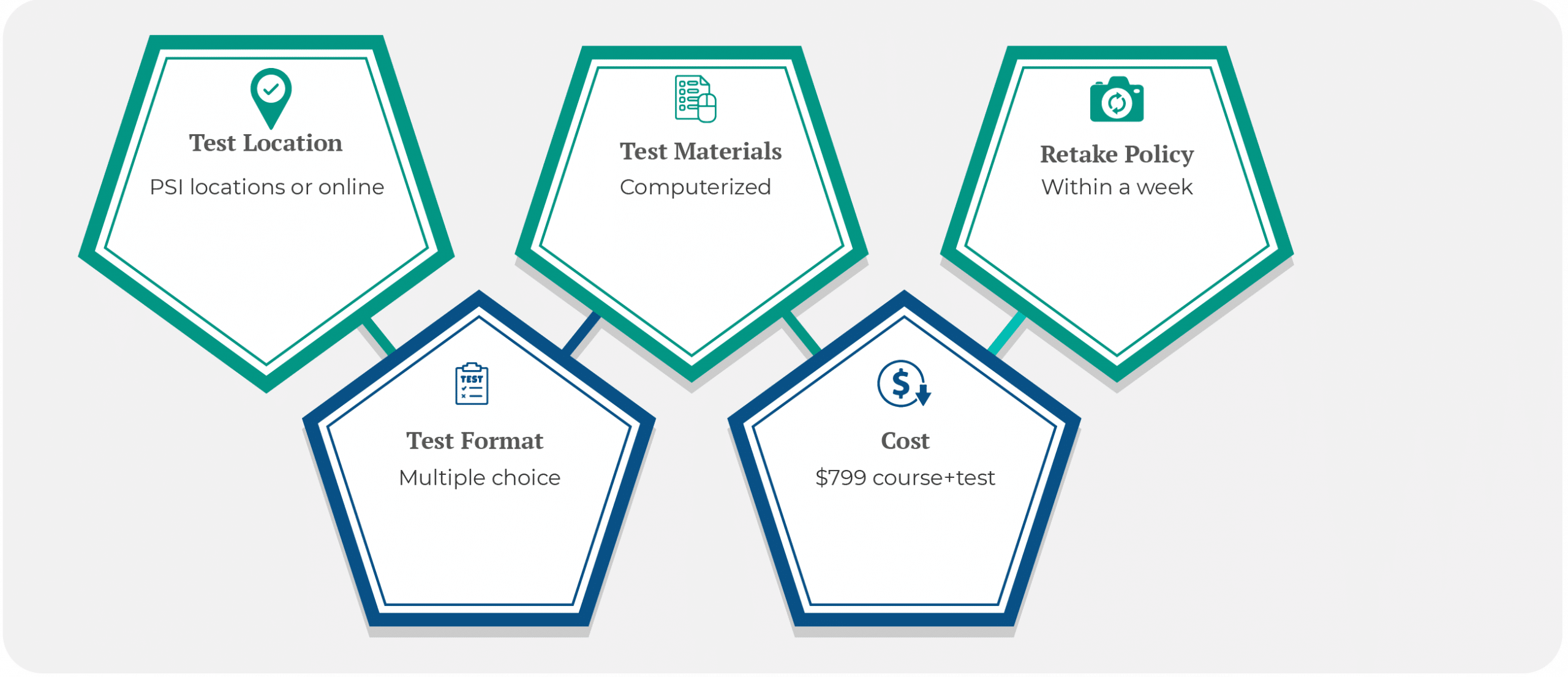
Test Provider
The test is created by the National Academy of Sports Medicine as part of its personal trainer certification and is accredited by the NCCA. NASM courses use their proprietary Optimum Performance Training™ (OPT™) model, a system based on scientific, evidence-based research. These courses maximize your skills and ability to help your clients excel beyond ordinary expectations while improving your career opportunities.
The test is administered by PSI, a standalone subsidiary of ETS, which has over 70 years of experience delivering successful testing programs.
Information Sources
- NASM – National Academy of Sports Medicine
- NCCA – the National Council for Curriculum and Assessment
- PSI Exams
Disclaimer – All the information and prep materials on iPrep are genuine and were created for tutoring purposes. iPrep is not affiliated with the National Academy of Sports Medicine, NCCA, PSI Services LLC, or any other company mentioned.
Free NASM practice test: Get to know what the NASM CPT exam will be like by practicing with these sample questions:
Question 1 of 8
Which type of joint is the hip joint?
- Hinge joint
- Ball and socket joint
- Pivot joint
- Saddle joint
The hip joint is a ball and socket joint.
This type of joint permits movement in all directions. The ball and socket joint features the rounded head of one bone sitting in the cup of another bone.
In the hop joint, the femoral head (part of the femur bone) is the ball; the acetabulum (part of the pelvis) is the socket.
Question 2 of 8
What is the main purpose of circuit training?
- build endurance, burn calories, and athlete training
- high-Intensity training that defines muscles and increases metabolism
- increase mobility and range of motion, and improve posture
- full body workouts that waste little time
Circuit training is full-body workouts that waste little time since it alternates between several exercises targeting different muscle groups.
Aerobic training or Cardio builds endurance, burns calories, and suits athlete training.
Interval training is high-Intensity training that defines muscles and increases metabolism.
Flexibility training increases mobility and the range of motion, as well as improves posture and balance.
Question 3 of 8
Which weight status is associated with a BMI of 22.5 kg/m2
- Underweight
- Normal/Healthy weight
- Overweight
- Obese
The correct answer is Normal or Healthy weight.
The following table summarizes the standard weight status categories associated with BMI (Body Mass Index) ranges for adults:
| BMI | Weight Status |
|---|---|
| Below 18.5 | Underweight |
| 18.5 – 24.9 | Normal or Healthy Weight |
| 25.0 – 29.9 | Overweight |
| 30.0 and Above | Obese |
Question 4 of 8
What does diastolic blood pressure measure?
- the pressure in the arteries when your heart rests between beats
- the pressure in the arteries when your heart beats
- the pressure in the veins when your heart rests between beats
- the pressure in the veins when your heart beats
Blood pressure is measured as (Systolic pressure / Diastolic pressure).
Systolic pressure is the pressure in the arteries when your heart beats.
Diastolic pressure is the pressure in the arteries when your heart rests between beats.
Question 5 of 8
Dehydration invoke various bodily responses, all of which try to maintain the person’s _______________ .
- consciousness
- metabolism
- homeostasis
- innervation
The correct answer is homeostasis.
In biology, homeostasis is the state of steady internal, physical, and chemical conditions maintained by the body. One aspect of homeostasis is proper levels of water within the body. Dehydration is defined as the excessive loss of body fluid. This may disturb various processes in the body such as maintaining the body temperature. If you lose too much water, perspiration will cease and there will be a threat of body temperature rise, which may lead to heat exhaustion. When the body is dehydrated, various hormonal mechanisms will try to regain water balance, and as a result the homeostasis, by increasing water intake (e.g. thirst) and decreasing water output (e.g. reduced urine output).
Question 6 of 8
Which of the following muscle pairings do not exhibit reciprocal inhibition and altered reciprocal inhibition?
- hamstrings and quadriceps
- biceps and triceps
- deltoids and latissimus dorsi
- calves and glutes
Reciprocal inhibition is a neuromuscular reflex that inhibits opposing muscles during movement. This plays a significant role in improving the efficiency of the human movement system.
All the above pairing exhibit this phenomenon except for calves and glutes.
Question 7 of 8
Which statement is the most accurate statement regarding resting heart rates?
- Resting heart rates of men are typically greater than those of women
- Resting heart rates of women are typically greater than those of men
- Resting heart rates of men and women are typically the same
Resting heart rates of women are typically greater than those of men.
The smaller female heart, pumping less blood with each beat, needs to beat at a faster rate to match the larger male heart’s output.
Question 8 of 8
Which phase is not part of Level 2 of the NASM OPT™ Model?
- Power
- Maximal Strength
- Strength Endurance
- Muscular Development
The correct answer is Power.
The NASM OPT™ Model is a 3-level, 5-phases fitness training system.
Level 1: Stabilization
- Phase 1: Stabilization Endurance
Level 2: Strength
- Phase 2: Strength Endurance
- Phase 3: Muscular Development
- Phase 4: Maximal Strength
Level 3: Power
- Phase 5: Power
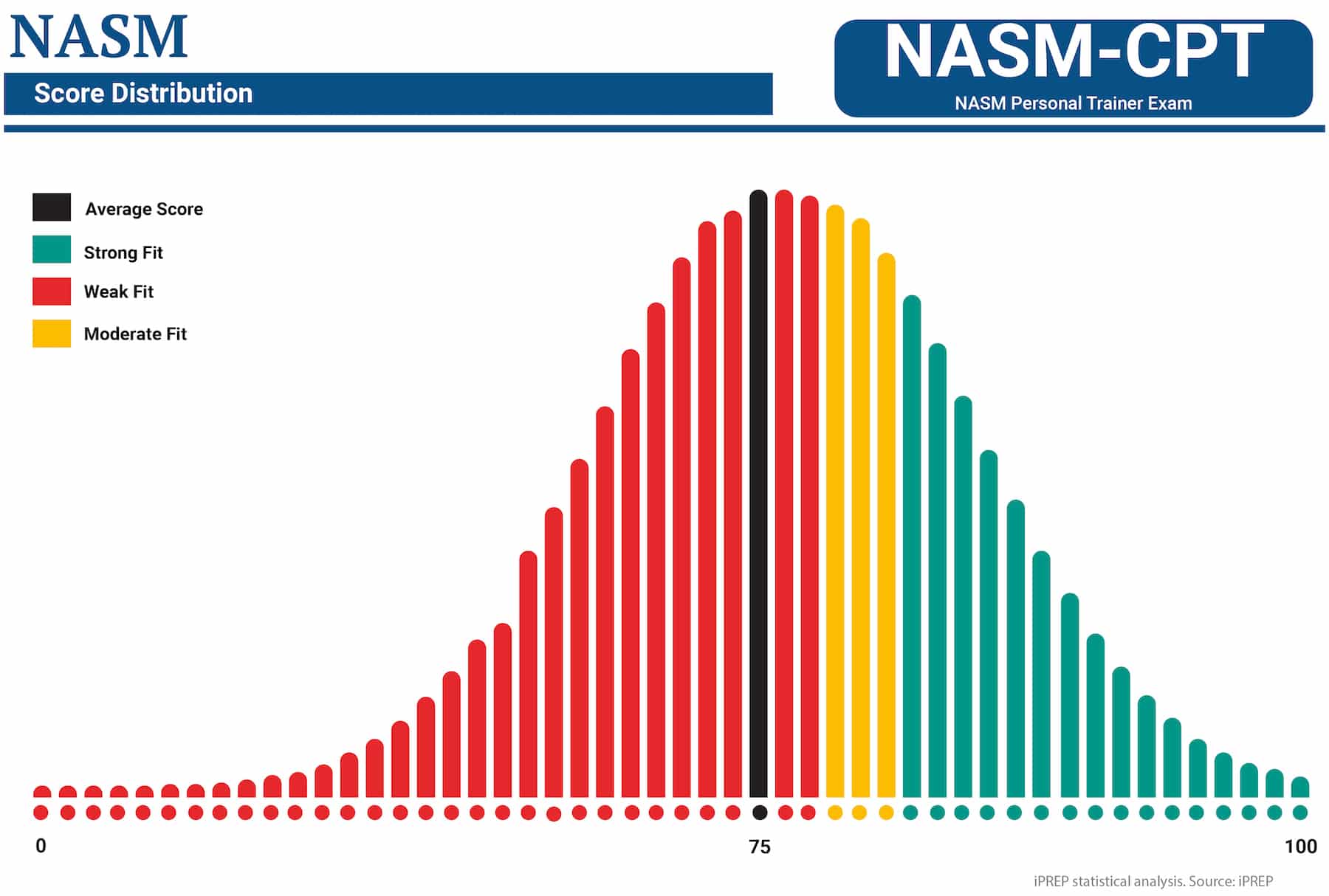
Well done!
You have completed the Sample Questions section.
The complete iPREP course includes full test simulations with detailed explanations and study guides.
‘…TESTS THAT ACTUALLY HELP’

In the first 30 minutes of use I have learned so much more than skipping along the internet looking for free content. Don’t waste you time, pay and get tests that actually help.
Richard Rodgers
January 28, 2020 at 7:49 PM
